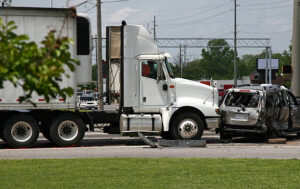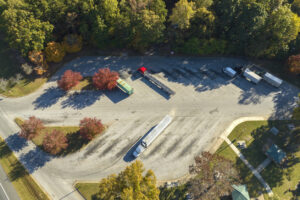Over five days this summer, commercial motor vehicle inspectors conducted 3,929 inspections of commercial motor vehicles transporting hazardous materials/dangerous goods (HM/DG) as part of the Commercial Vehicle Safety Alliance’s (CVSA) unannounced HM/DG inspection and enforcement initiative.
According to the media release, during the HM/DG Road Blitz, inspectors affixed 1,009 CVSA decals, which means there were no critical vehicle or specification cargo tank violations on those vehicles. On the other hand, inspectors discovered HM/DG violations on 576 of the vehicles inspected. Vehicles with out-of-service HM/DG violations were removed from roadways until those violations were corrected.
Forty-five jurisdictions participated in this year’s unannounced HM/DG Road Blitz, which was June 10-14. A total of 4,095 packages were inspected; specifically, 1,488 non-bulk packages/small means of containment, 2,218 bulk cargo tank packages/large means of containment and 389 other bulk packages/other large means of containment.
“There were 116 out-of-service loading and securement violations in North America,” the release said. “Loading and securement requirements prevent cargo/goods/materials from moving in a manner that would cause damage to the package resulting in leaking, spilling, etc., in a commercial motor vehicle. This is especially important when it comes to the transportation of HM/DG.”
Nineteen packages were cited for HM/DG package integrity (leaking) violations. Leaking hazardous materials or dangerous goods pose a significant threat to human health and safety, property, and the environment.
According to the U.S. Pipeline and Hazardous Materials Safety Administration (PHMSA), a hazardous material is a substance or material that is capable of posing an unreasonable risk to health, safety and property when transported in commerce. The U.S. Department of Transportation’s Bureau of Transportation states that 3 billion tons of hazardous materials were shipped in the U.S. in 2017. To minimize the risks associated with transporting hazardous materials, anyone involved in HM transportation in commerce is required to comply with the federal Hazardous Materials Regulations (HMRs). The HMRs govern the transportation of hazardous materials in interstate, intrastate and foreign commerce.
The release noted that In the U.S., inspectors discovered 93 undeclared packages during the five days of the blitz. According to PHMSA, each year, approximately 1,500 transportation incidents occur when undeclared hazardous materials are shipped. Hazardous materials must always be properly classified, packaged, labeled, handled and stowed for transportation. This protects workers, emergency responders and the general public from the risks associated with HM transportation.
In Canada, dangerous goods are defined as any substance or material capable of posing an unreasonable risk to health, safety and property when transported in commerce. Shipments of dangerous goods number in the multi-millions annually. The federal, provincial and territorial governments of Canada enacted legislation to regulate the transportation of dangerous goods via the Transportation of Dangerous Goods (TDG) Regulations. Canada’s TDG Regulations prescribe safety standards and shipping requirements for dangerous goods and communicate the nature and level of hazard and risk associated with those dangerous goods.
In Canada, inspectors identified 79 TDG training certificate violations. The purpose of the training certificate is to demonstrate that the individual handling and/or transporting dangerous goods is properly trained and competent to safely fulfill their duties, according to the release.
There are nine recognized classes of HM/DG. These classes designate HM/DG into categories based on the materials’ chemical and physical properties and the risks associated with those materials.
The transportation of HM/DG demands rigorous training and heightened compliance requirements. For motor carriers and drivers, safely transporting HM/DG is imperative to the safety of the driver, the public and the environment. For inspectors, inspecting vehicles transporting HM/DG is a complex and detailed process that involves safely looking for leaking materials or unsecured HM/DG cargo, and checking and verifying shipping papers, placarding, marking, labeling, packaging and loading compliance.
CVSA’s annual unannounced HM/DG Road Blitz aims to:
- Remove vehicles with HM/DG out-of-service violations from roadways.
- Spotlight the importance of the programs, processes and regulations associated with the safe transportation of HM/DG.
- Recognize safety-compliant HM/DG drivers, motor carriers, manufacturers, shippers, etc.
- Highlight the specially trained inspectors who prioritize transportation safety by inspecting vehicles transporting HM/DG and enforcing strict compliance regulations.
- Identify HM/DG shipping paper, placarding, marking, labeling, packaging and loading compliance violations.
The HM/DG Road Blitz is an annual unannounced HM/DG inspection and enforcement initiative made possible through participation from CVSA’s member jurisdictions throughout North America. It is supported by the U.S. Pipeline and Hazardous Materials Safety Administration and the Federal Motor Carrier Safety Administration, Transport Canada, and Mexico’s Ministry of Infrastructure, Communications and Transportation. The initiative was adopted by the CVSA Hazardous Materials Committee, which provides technical HM/DG guidance and assistance to government and industry in an effort to reduce HM/DG incidents and encourage uniformity and consistency in the application of the regulations.






